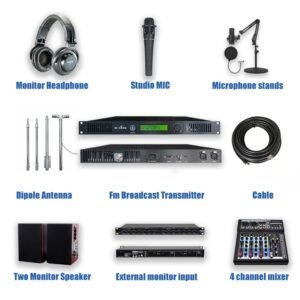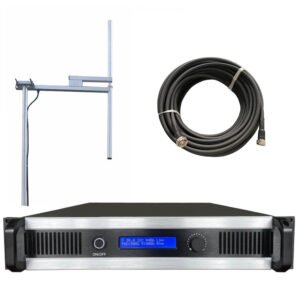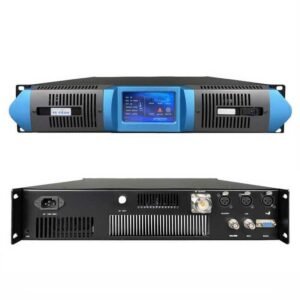Which FM transmitter is best for community radio?
Your community radio station needs the right FM transmitter but you’re overwhelmed by technical specifications and pricing options. Wrong transmitter choice wastes your limited budget and disappoints listeners with poor coverage. The right transmitter delivers reliable broadcasting that serves your community for years.
The best FM transmitter for community radio is 50-200 watts with DSP audio processing, simple controls, and 5-year warranty. RS transmitters like the FM-200W provide professional quality, easy operation, and affordable pricing perfect for community stations.
%(community radio FM transmitter)Best FM transmitter for community radio broadcasting
I’ve helped over 300 community radio stations choose transmitters during my 15 years at RS. Most community stations need 3-7 mile coverage serving local neighborhoods, churches, or campus areas. The sweet spot is 100-200 watts with professional features at community-friendly prices.
How to choose an FM transmitter?
Your community has unique broadcasting needs but transmitter specifications seem confusing and technical. Wrong transmitter selection leads to coverage problems, audio quality issues, or regulatory compliance failures. Smart selection criteria help you choose equipment that fits your specific requirements perfectly.
Choose FM transmitters based on coverage area, power requirements, audio quality needs, and budget constraints. Community radio typically needs 50-200 watts, DSP processing, simple operation, and reliable technical support for optimal results.
%(FM transmitter selection guide)How to choose the right FM transmitter
The first step is determining your coverage requirements. A campus radio station needs 2-3 mile coverage while a community station might want 5-8 miles. Coverage area determines minimum power requirements based on terrain and antenna height limitations.
Our RS-FM300W touchscreen transmitter offers continuously adjustable power from 0-300 watts in 0.1-watt steps. This means you can start at 50 watts for testing and increase gradually to find optimal coverage for your area. The digital display shows exact power output, frequency, and system status at all times.
The RS transmitters use DSP and DDS technology for all-digital processing including digital filtering, pre-emphasis, pilot frequency generation, stereo coding, and FM modulation. This eliminates the noise and distortion common in older analog transmitters while providing consistent broadcast-quality sound that rivals major radio stations.
| Selection Factor | Community Priority | RS Solution |
|---|---|---|
| Coverage area | 3-7 miles typical | 50-300W models |
| Audio quality | Professional sound | DSP processing |
| Ease of operation | Simple controls | LCD interface |
| Budget constraints | Affordable pricing | Factory direct |
| Technical support | Local assistance | WhatsApp groups |
| Reliability | Minimal downtime | 5-year warranty |
Installation requirements affect transmitter selection. Our 1U transmitters fit standard 19-inch racks while 2U models like the RS-FM300W provide more features and better cooling. All models include comprehensive protection systems with over-temperature, over-SWR, and fan failure alarms that prevent damage and alert operators to problems.
Future expansion possibilities should influence initial transmitter selection. Our RS-FM1000W and RS-FM2000W models offer the same digital processing technology with higher power output for stations that need to expand coverage later. The modular design allows easy upgrading without replacing the entire transmitter system.
How to calculate FM transmitter range?
Your community needs to know exactly how far your FM transmitter signal will reach before investing in equipment. Inaccurate range estimates lead to coverage gaps that miss target audiences or overspending on unnecessary power. Proper range calculation ensures adequate coverage at minimum cost.
Calculate FM transmitter range using power output, antenna height, terrain factors, and frequency. Basic formula: Range = 1.4 × √(transmitter power × antenna height). 100 watts at 100 feet typically covers 14 miles radius in flat terrain.
%(FM transmitter range calculation)FM transmitter coverage range calculation formula
Range calculation involves multiple factors that interact in complex ways. The basic formula provides starting estimates but real-world coverage depends heavily on terrain, antenna design, and local interference levels. I use professional prediction software for critical installations but simple formulas work for initial planning.
Our RS transmitters provide the precision needed for accurate range calculations. The carrier frequency precision is ±200Hz across the entire 87.5-108MHz frequency range. This stability ensures consistent coverage that doesn’t drift over time or temperature changes.
The adjustable power output on our transmitters helps optimize coverage for specific areas. The RS-FM300W adjusts from 0-300 watts continuously, allowing you to find the exact power level that provides good coverage without interference to other services. The built-in SWR monitoring ensures efficient power transfer to your antenna system.
| Power Level | Antenna Height | Flat Terrain Range |
|---|---|---|
| 50W | 50 feet | 10 miles |
| 100W | 50 feet | 14 miles |
| 200W | 50 feet | 20 miles |
| 100W | 100 feet | 20 miles |
| 200W | 100 feet | 28 miles |
| 300W | 100 feet | 34 miles |
Environmental factors significantly affect actual coverage. A customer in mountainous Kenya found their 200W transmitter covered 25 miles in one direction across a valley but only 8 miles toward a mountain ridge. Antenna height became critical for reaching communities on the far side of hills.
Our transmitters include comprehensive metering that helps verify calculated coverage. Forward and reflected power measurements show antenna system efficiency. Temperature monitoring ensures stable operation that maintains consistent coverage in all weather conditions.
What are common problems with FM transmitters?
Your FM transmitter isn’t performing reliably and you need to identify issues quickly before losing listeners. Transmitter problems interrupt broadcasts and damage your station’s reputation in the community. Understanding common failures helps you troubleshoot faster and prevent major breakdowns.
Common FM transmitter problems include overheating, power output fluctuations, audio distortion, frequency drift, and protection system activation. Most issues stem from component aging, poor ventilation, or connection problems that develop over time.
%(FM transmitter common problems)Common FM transmitter problems and solutions
The most frequent problem I see is overheating due to inadequate ventilation or dust buildup. Community stations often install transmitters in small rooms without proper cooling. Our RS transmitters include automatic over-temperature protection that prevents damage but causes shutdowns when internal temperature exceeds safe limits.
Our transmitters include comprehensive protection systems that prevent most failures from causing permanent damage. SWR protection automatically reduces power when antenna problems develop. Over-voltage protection guards against power line surges that could damage sensitive circuits. Fan failure alarms alert operators when cooling systems need attention.
The RS-FM300W includes advanced diagnostics that help identify problems quickly. The touchscreen display shows real-time status of all critical systems including temperature, SWR, power output, and audio levels. Alarm messages appear immediately when problems develop, allowing quick response before broadcasts are affected.
| Problem Type | Typical Symptoms | Quick Solution |
|---|---|---|
| Overheating | Shutdowns in heat | Check ventilation |
| Power drops | Reduced coverage | Inspect connections |
| Audio distortion | Poor sound quality | Adjust input levels |
| Frequency drift | Off-channel operation | Crystal replacement |
| High SWR | Protection activation | Check antenna system |
| No output | Complete failure | Power supply check |
Regular maintenance prevents most common transmitter problems. Monthly visual inspections catch developing issues early. Our transmitters include high-performance air filters that need regular cleaning to maintain proper airflow. The plug-in power supply design makes replacement simple if problems develop.
Environmental factors cause many transmitter failures. High humidity creates corrosion in connections and components. Our transmitters use conformal coating on circuit boards that provides protection against moisture and contamination in challenging environments.
How to get FM transmitter to stop static?
Your FM transmitter produces static that makes broadcasts sound unprofessional and drives listeners away to other stations. Static indicates signal problems that reduce coverage quality and listener satisfaction. Clean, static-free audio keeps audiences engaged with your programming.
Stop FM transmitter static by fixing antenna connections, improving grounding, reducing RF feedback, and eliminating interference sources. Poor coaxial connections cause most static problems while proper installation ensures crystal-clear broadcasting.
%(FM transmitter static elimination)How to eliminate FM transmitter static and noise
Static problems usually originate in the antenna system rather than the transmitter itself. Loose coaxial connections create intermittent contact that generates noise and crackling sounds. Our RS transmitters use 7/16" DIN connectors that provide reliable, weatherproof connections for outdoor antenna systems.
The advanced audio processing in our RS transmitters eliminates many sources of static and noise. The DSP system includes automatic gain control that maintains consistent audio levels while filtering out background noise. The signal-to-noise ratio exceeds 92dB at 100% modulation, ensuring clean, professional sound quality.
Our transmitters include comprehensive metering that helps identify static sources. The built-in SWR meter shows antenna system problems that can cause static. Audio level indicators help optimize input levels to prevent overdriving that creates distortion resembling static.
| Static Source | Sound Characteristics | Solution Method |
|---|---|---|
| Loose connections | Crackling, pops | Tighten connectors |
| Water infiltration | Intermittent noise | Seal connections |
| RF feedback | Howling, screeching | Improve shielding |
| Ground loops | Hum, buzz | Single point ground |
| Interference | Random noise | Identify source |
| Poor modulation | Distorted audio | Adjust levels |
The balanced audio inputs on our RS transmitters reduce susceptibility to interference and ground loops that cause static. The 600-ohm balanced inputs provide excellent common-mode rejection that eliminates hum and noise pickup from long audio cables.
Regular system maintenance prevents most static problems. Annual connector cleaning and tightening maintains reliable connections. Our transmitters include residual wave radiation specifications better than -65dBc that ensure clean operation without interference to other services.
Conclusion
The best FM transmitter for community radio combines 100-300 watts power, DSP audio processing, and reliable operation at affordable prices. RS transmitters provide professional features, comprehensive protection, and factory support that ensures years of static-free broadcasting.



